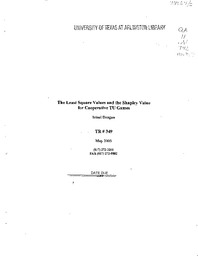
ATTENTION: The works hosted here are being migrated to a new repository that will consolidate resources, improve discoverability, and better show UTA's research impact on the global community. We will update authors as the migration progresses. Please see MavMatrix for more information.
Show simple item record
| dc.contributor.author | Dragan, Irinel C. | en |
| dc.date.accessioned | 2010-06-03T18:19:22Z | en |
| dc.date.available | 2010-06-03T18:19:22Z | en |
| dc.date.issued | 2003-05 | en |
| dc.identifier.uri | http://hdl.handle.net/10106/2344 | en |
| dc.description.abstract | **Please note that the full text is embargoed** ABSTRACT: The Least Square Values (briefly LS-values), represent a family of values for cooperative transferable utility games, introduced by L. Ruiz. F. Valenciano and J.Zarzuelo (1998). For a fixed set of players N, a set of weights [see pdf for notation], and any TU-game v , M.Keane (1968) has defined and solved a quadratic programming problem: minimize the sum of weighted squares of deviations of the excesses from their average, on the preimputation set. He has shown that this problem has a unique solution which depends on the weights and has also given the new computational formula. Further, Ruiz/Valenciano/Zarzuelo have called this solution an LS-value, have characterized axiomatically this family of values and have also given many properties.
In the present paper. we start by showing that from this formula one can derive another new computational formula, similar to the formula given by the author for the Shapley value (see Dragan, 1992) and called an Average per capita formula. An algorithm for computing the LS-values in parallel and using only n operations more than in the case of the Shapley value is stated. A by product of the same formula is the result that an LS-value is the Shapley value of a game easily obtained by rescaling from the given game. This fact suggests that the LS-values have more properties similar to the Shapley value than the ones discovered by Ruiz/Valenciano/Zarzuelo. The LS-value is defined on any space of TU-games and its subspaces: we define a quasi-potential function of the Hart/Mas Colell type (1988, 1989). A potential basis for such a space, introduced by the author for the Shapley value and the weighted Shapley value (1991), and the Banzhaf value (1996) is allowing us to solve for the LS-values what we call the Inverse Problem: given a vector [see pdf for notation] and a weight vector [see pdf for notation], find out an explicit formula giving all games v with the set of players N for which the LS-value corresponding to y is exactly (1) . In particular. for[see pdf for notation] = 0 we find the null space of the LS-value : the nullity equals . The inverse problem in the cases shown above were solved earlier bythe author. In the first section. we prove the Average per capita formula for LS-values and corollaries, in the second section we introduce the quasi-potential and the potential basis, and in the last section we solve the inverse problem. | en |
| dc.language.iso | en_US | en |
| dc.publisher | University of Texas at Arlington | en |
| dc.relation.ispartofseries | Technical Report;349 | en |
| dc.subject | Shapley value | en |
| dc.subject | TU games | en |
| dc.subject | Banzhaf value | en |
| dc.subject | Least square values | en |
| dc.subject | LS-value | en |
| dc.subject | Transferable utility games | en |
| dc.subject | Inverse problem | en |
| dc.subject | Cooperative game | en |
| dc.subject.lcsh | Mathematics Research | en |
| dc.title | The Least Square Values and the Shapley Value for Cooperative TU Games | en |
| dc.type | Technical Report | en |
| dc.publisher.department | Department of Mathematics | en |
Files in this item
- Name:
- MathTechReport349.pdf
- Size:
- 506.8Kb
- Format:
- PDF
- Description:
- PDF
This item appears in the following Collection(s)
Show simple item record


